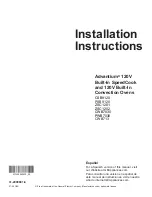
10
ELECTRICAL REQUIREMENTS
The appliance must be connected to the mains checking that the voltage correspon-
ds to the value given in the rating plate and that the electrical cable sections can
A suitable isolating switch providing full disconnection from the mains power supply
shall be incorporated in the permanent wiring, mounted and positioned to comply with
the local wiring rules and regulations. The isolating switch must be of an approved
type and provide a 3 mm air gap contact separation in all poles (or in all active [phase]
conductors if the local wiring rules allow for this variation of the requirements).
The isolating switch shall be easily accessible to the customer with the oven installed.
The power supply cable must not touch the hot parts and must be positioned so that it
does not exceed 75°C above ambient.
To connect the appliance to the mains electricity supply, do not use adapters, reducers
or branching devices as they can cause overheating and burning.
If the supply cord is damaged it must be replaced by the manufacturer or it’s Service
Q$
N.B. The connection of the appliance to earth is mandatory.
-
trician. He should also check that the domestic electrical system is suitable for the power
drawn by the appliance.
-
cordance with the instructions supplied by the manufacturer and in compliance with
established electrical regulations.
CONNECTING THE POWER SUPPLY CABLE
Important! This appliance must be connected to the electricity supply only by an
authorised person.
Unscrew the screw “
A
” securing the cover plate “
B
V?X@
Remove the cover plate “
B
”.
Remove the screws “
C
V ?\@
Insert the mains cable (type V105 - 3 x 2,5 mm
2
section) into the cable protector “
P
”.
Connect the phase, neutral and earth wires to the mains terminal connection block “
D
”.
%
GREEN AND YELLOW - EARTH
%
BLUE - NEUTRAL - “
N
”
%
BROWN - LIVE - “
L
”











































